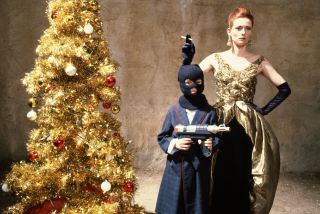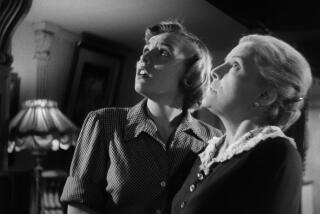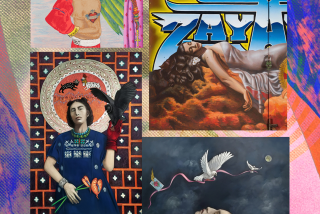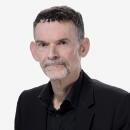Avant-garde films are at home in REDCAT
- Share via
In the Darwinian world of L.A. film culture, Hollywood blockbusters are the toothy carnivores gobbling up the biggest budgets and the most movie screens. Then come indies, documentaries and foreign films, quietly staking out their smaller patches of swamp (read: niche markets).
Finally, there are experimental and avant-garde films and videos, wilier and brainier than the lumbering big-studio giants. But these cinematic marsupials are precariously balanced on the edges of the movie ecosystem, always vulnerable to budget slashing and spotty media coverage.
“This kind of filmmaking, I don’t want to call it an endangered species, but it’s fragile,” said Berenice Reynaud, who, with Steve Anker, co-curates film and video programming at REDCAT, the multimedia performance venue hunkered on the ground floor of the Walt Disney Concert Hall.
Endangered perhaps, yet alternative film and video is still surviving, and on certain nights thriving, at a handful of regional venues including Los Angeles Filmforum and the UCLA Film and Television Archive.
None is more daringly ambitious than Film at REDCAT . Now in its seventh season, REDCAT regularly programs artists whose work pushes beyond conventional narrative cinema. It provides a forum for international film and multimedia artists, as well as for filmmakers whose work often proceeds from urgent questions of ethnicity, sexuality and politics, or merges film with other arts (dance, theater, installation) and blurs distinctions between cinematic genres and storytelling forms.
A number of these auteurs also use their work to investigate the very nature of the moving image, making viewers think critically about the way we process visual experience and construct stories in our minds out of what are essentially still-photo sequences illuminated by a projector.
For example, this year’s season opens Tuesday with an appearance by veteran “film projection artist” Bruce McClure, whose work has been shown at the Whitney Biennial, presenting a program with the imposing but pun-happy title, “Locative Enigma -- Frameshape of Hard Mettles -- Personal Problem: Projection Performances by Bruce McClure.”
Somewhat like the silent movie organists of the pre-talkie era, McClure “performs” movies on a battery of projectors, flipping switches, fidgeting with camera lenses and using other visual interventions to create an un-reproducible, stream-of-consciousness symphony of images.
Avant-garde film screenings sometimes carry cultist associations. It’s not necessary to bone up on your Roland Barthes before attending most REDCAT programs, though a familiarity with the abstract paintings, films and animation of the late German-born L.A. artist Oskar Fischinger might be helpful for understanding the Nov. 3 program of Joost Rekveld’s work titled “Lichtspiel: Contemporary Abstract Animation and Visual Music.”
But audience members don’t need any scholarly prompting to get into the spirit of a program such as last season’s “Cinema Cabaret,” which allowed poets and writers to visually mash-up Hollywood classics like “Who’s Afraid of Virginia Woolf?” and “On the Beach” and add their own (digressive? ironic?) voice-overs.
One of REDCAT’s goals, Reynaud said, is to “show that experimental cinema is fun, it’s joyful, it’s entertaining.” She and Anker base their curatorial choices on the assumption that L.A. audiences are sophisticated film connoisseurs. Among REDCAT’s regular attendees are film industry professionals and others seeking adventurous cinema at a time when its commercial counterpart is less adventurous than ever.
“When I arrived, I was told there is no audience in Los Angeles for experimental film,” Anker recalled during a recent interview with Reynaud at a Highland Park coffee house. “And almost as soon as we began the screenings we were getting larger audiences.”
In contrast to LACMA and other institutions that typically program film by themes or with retrospectives of a director or actor, REDCAT’s programming doesn’t fall into neat categories.
This season will include works by Chinese experimental animator Sun Xun (Oct. 19); a Halloween showing of the creepy Expressionist classic “The Golem,” with live musical accompaniment; and Village Voice film critic J. Hoberman leading a screening and discussion of Jack Smith’s “Flaming Creatures,” the outlandish 1963 gay-underground masterpiece that plays like a John Waters fever dream hijacked by Federico Fellini, or vice versa.
Also slated is a documentary double bill on indigenous Mexican culture (Dec. 14), an exploration of Persian-language satellite television (Nov. 5) and “A Nervous Magic Lantern Performance” by 3-D master Ken Jacobs (Oct. 12).
“If there is anything that unifies this [series], it’s the idea of the independent artist as auteur,” Anker said. “It’s generated by the vision of the sole artist.”
--
More to Read
The biggest entertainment stories
Get our big stories about Hollywood, film, television, music, arts, culture and more right in your inbox as soon as they publish.
You may occasionally receive promotional content from the Los Angeles Times.











